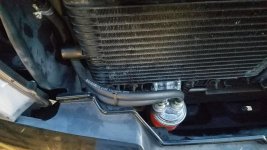BajaRon
Well-known member
Curious as to the hydraulics work on this....is it not the same oil source?
There seems to be a fair number of misconceptions about the SE6 HCM filter.
Changing the HCM filter is tricky or hard to do, (Not)
You need BUDS to change the HCM filter, (Not)
The HCM filter, filters the transmission oil, (Not). I will admit some culpability on this one as I reference this as a 'Transmission' filter (which it is not) because many relate to this terminology but have no idea what an HCM is.
The transmission runs in it's own, separate oil, (Not)
This filter treats only that oil which is then sent to the hydraulic control mechanism (or module, I can't remember which). The HCM takes the place of your foot on the shift lever and your hand squeezing the clutch lever. That's all it does. Shift up, shift down. The transmission gears run in the same oil as the engine and that oil is filtered by the engine oil filter.
Last edited:

